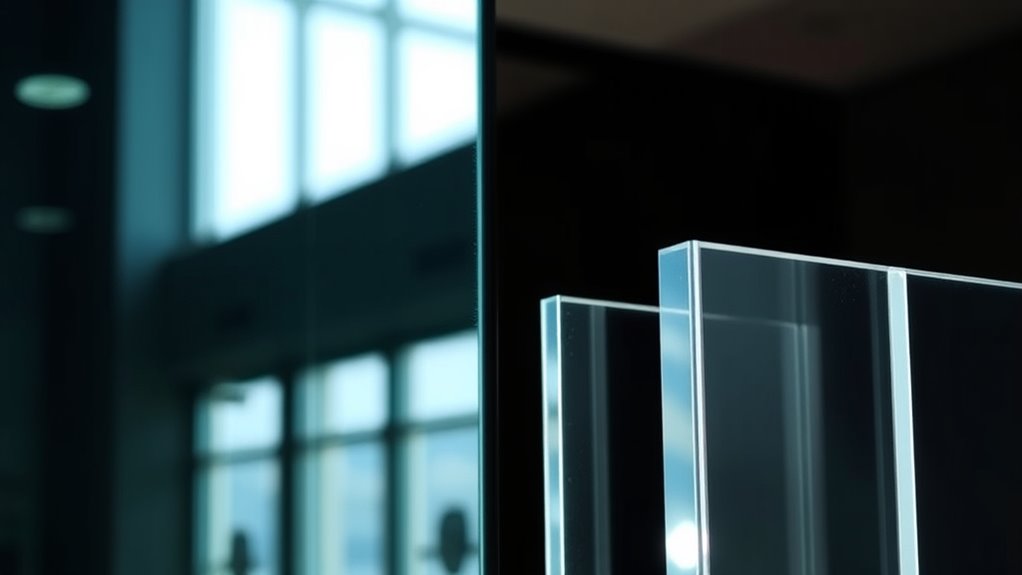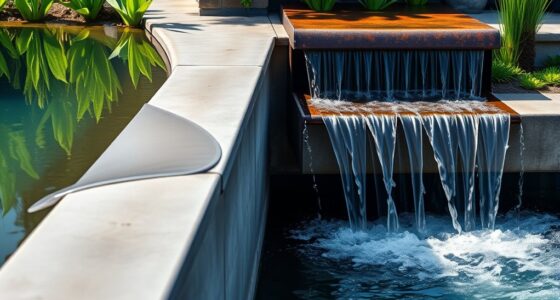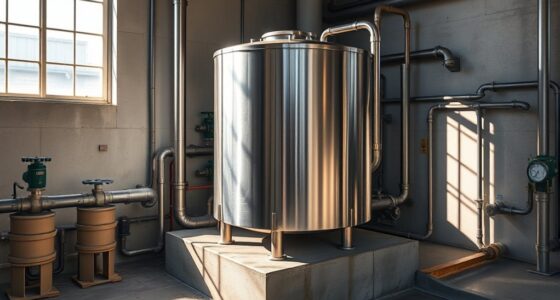Choosing the right edges for glass walls and acrylic panels influences their look, safety, and durability. Polished or rounded edges boost safety and create sleek aesthetics, while textured or frosted finishes add privacy and diffuse light beautifully. Consider costs, maintenance, and sustainability to find options that fit your space and style. With proper selection, you enhance your design’s appeal and functionality. Explore further to discover how different edges can truly elevate your project’s overall impact.
Key Takeaways
- Customizable edges enhance aesthetic appeal and allow seamless integration with architectural details.
- Polished edges improve brightness and light dispersion, creating a vibrant and open atmosphere.
- Rounded or beveled edges increase safety by reducing sharpness and injury risk.
- Certain edge finishes, like textured or frosted, may diffuse light but can complicate cleaning and maintenance.
- The choice of edge materials influences durability, cost, and ease of installation, impacting long-term performance.
Aesthetic Appeal and Design Flexibility
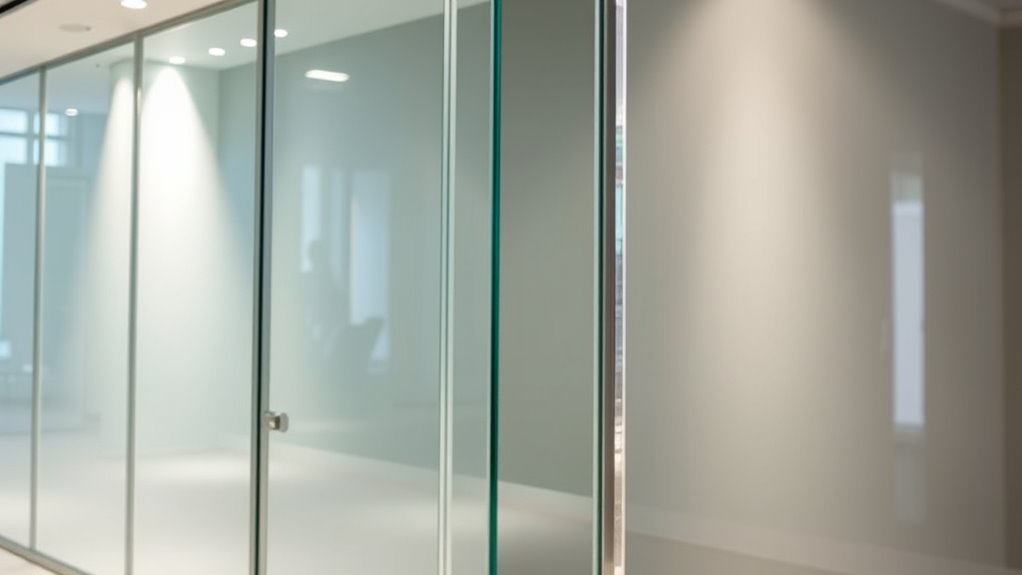
When it comes to enhancing interior spaces, the aesthetic appeal and design flexibility of glass wall and acrylic panel edges play a essential role. You have the ability to choose from sleek, seamless edges or decorative finishes that match your style. These options allow you to create modern, minimalist looks or intricate designs that add character. The transparency and smoothness of glass and acrylic edges contribute to a clean, polished appearance, making spaces look larger and more open. You can also customize edges to integrate with various architectural details, ensuring harmony with your overall design. This flexibility means you’re not limited in how you shape your environment—your vision can be realized with edges that complement your aesthetic goals perfectly.
Light Transmission and Openness

By choosing glass walls or acrylic panels, you allow more natural light to flow throughout your space, making it feel brighter and more inviting. This openness enhances visual connectivity, so you stay connected with your surroundings. As a result, your environment gains a sense of spaciousness and vibrant ambiance.
Natural Light Flow
Have you ever noticed how the edges of glass walls and acrylic panels can influence the way light flows into a space? Sharp, smooth, or beveled edges affect how light passes through and disperses. When edges are polished and seamless, light travels more freely, creating a bright, open atmosphere. Conversely, frosted or textured edges can diffuse light, softening glare and shadows. This variation impacts the overall openness of a room. Imagine this:
| Clear, sharp edges | Diffused, frosted edges |
|---|---|
| Bright, direct light | Gentle, scattered glow |
| Sharp shadows | Soft, muted shadows |
| High transparency | Reduced transparency |
Additionally, the choice of edge finishing can influence light transmission and the overall aesthetic appeal of the space.
Visual Connectivity Enhances
Visual connectivity plays a crucial role in enhancing light transmission and creating a sense of openness within a space. When you use glass walls or acrylic panels, you allow natural light to flow freely, reducing barriers and fostering visual continuity. This openness encourages collaboration and interaction, making environments feel larger and more inviting. Additionally, the transparent surfaces provide unobstructed views, connecting different areas seamlessly. You also gain the flexibility to introduce decorative elements, like frosted or tinted finishes, without losing the sense of transparency. Furthermore, visual connectivity can improve safety by increasing visibility across spaces. Design flexibility allows for creative customization while maintaining openness. Overall, these features make your environment not only brighter but also more cohesive, fostering a feeling of transparency and inclusiveness.
Brightness and Ambiance
Using glass walls and acrylic panels markedly boosts the brightness and overall ambiance of a space. They allow natural light to flow freely, reducing dark corners and creating a sense of openness. This increased light makes the environment feel larger, more inviting, and energizing. Because these materials are transparent or semi-transparent, they soften the boundaries between areas, fostering a seamless, airy atmosphere. You’ll notice that rooms feel more vibrant and welcoming, encouraging productivity and comfort. Additionally, the reflective qualities of glass and acrylic enhance light distribution, amplifying brightness even further. Proper placement and material choice can also influence light transmission and openness, optimizing the space’s overall mood and visual appeal. Whether in an office, retail space, or home, these panels elevate the mood and visual appeal by maximizing light transmission and creating an open, luminous environment.
Safety Considerations and Edging Techniques
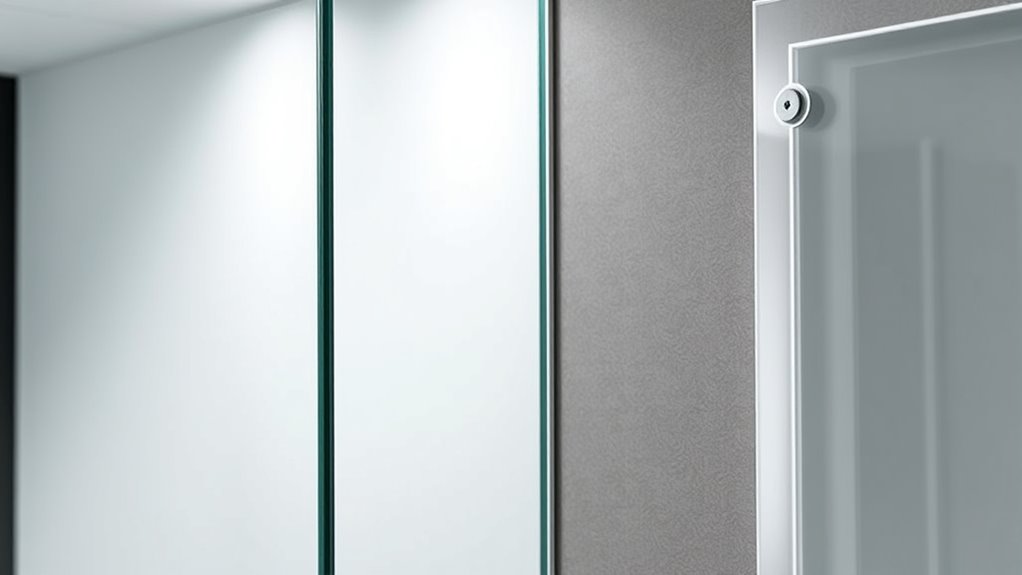
Guaranteeing safety when working with glass walls and acrylic panels is essential, especially at their edges where sharp or rough areas can pose risks. Proper edging techniques help prevent injuries and improve the overall safety of installations. You should consider rounded or beveled edges, which reduce sharpness and minimize the risk of cuts. Using protective films during fabrication can prevent chips and cracks. Edging materials like silicone or rubber can cushion edges and add grip. Regular inspections are vital to identify and address any damage or rough spots promptly. Additionally, ensure that edges are smooth, well-polished, and securely sealed to avoid potential accidents. Incorporating safety measures during installation and maintenance further enhances protection and reduces hazards.
Durability and Maintenance Needs

Proper edging techniques not only improve safety but also influence the durability of glass walls and acrylic panels. Well-finished edges help prevent chips, cracks, and other damage that can occur over time. Acrylic panels generally require less maintenance; regular cleaning with mild soap and water keeps them clear and scratch-free. Glass walls, on the other hand, need more careful cleaning to avoid streaks and mineral deposits, often using specialized glass cleaners. Edged panels with smooth, sealed finishes resist dirt buildup and reduce the risk of damage from impacts. You should inspect edges regularly for signs of wear or cracks and address issues promptly to extend the lifespan of your installation. Proper maintenance keeps your panels looking good and ensures they maintain their structural integrity for years.
Cost Factors and Installation Expenses

The cost of glass wall and acrylic panel edges varies considerably based on materials, design complexity, and installation requirements. You’ll find prices fluctuate depending on factors like edge type, thickness, and customization needs. For example, intricate edge finishes or custom shapes can increase labor and material costs. Additionally, installation expenses depend on site conditions, such as wall accessibility or structural support. Keep in mind these key cost factors:
- Material quality and thickness
- Edge finishing techniques
- Custom design and shaping
- Surface preparation requirements
- Labor and installation complexity
- Refrigerant management can also influence overall costs, especially when upgrading to environmentally friendly options.
Understanding these elements helps you budget accurately and choose options that balance aesthetics with cost efficiency. Being aware of these factors ensures you avoid unexpected expenses and make informed decisions for your project.
Environmental Impact and Sustainability
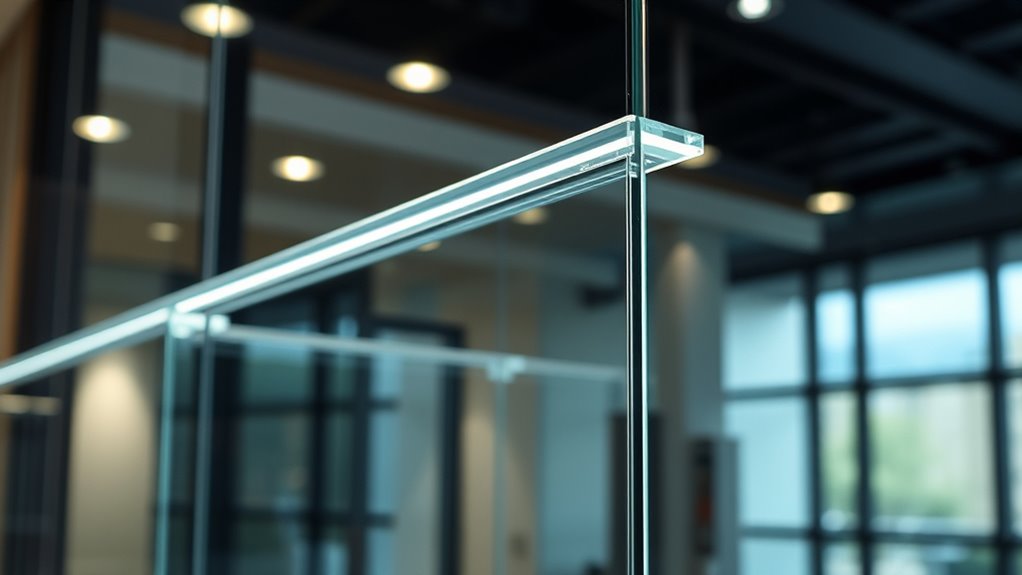
Choosing the right materials for glass wall and acrylic panel edges can substantially impact your project’s environmental footprint. Acrylic edges often have a lower carbon footprint since they require less energy to produce and can be recycled more easily. However, acrylic isn’t as durable as glass and may need replacement sooner, leading to more waste over time. Glass edges are typically made from silica sand, which involves energy-intensive manufacturing, but they are highly recyclable and long-lasting. When selecting materials, consider the lifecycle impacts, including production, durability, and recyclability. Opting for recycled or eco-friendly options can reduce waste and conserve resources. Additionally, glycolic acid, known for its effectiveness in exfoliation, is a reminder of how choosing environmentally friendly products can extend beyond construction materials to personal care, emphasizing sustainability in various aspects of your project and lifestyle. Your choices directly influence the sustainability of your project, helping you minimize environmental impact while maintaining aesthetic and functional quality.
Customization and Adaptability for Different Spaces

Since every space has unique requirements, selecting glass wall and acrylic panel edges that can be tailored guarantees they fit seamlessly into your design. Customization options allow you to choose different profiles, finishes, and sizes, ensuring the edges complement your aesthetics. Adaptability means these materials can be easily modified to suit various layouts or future changes. You can incorporate features like rounded corners, custom colors, or specific sealing mechanisms to meet functional needs. This flexibility helps create a cohesive look while addressing practical considerations. Paint sprayer accessories such as specialized tips and strainers can enhance the application process for finishing these edges smoothly.
Frequently Asked Questions
How Do Edge Finishes Affect the Overall Look of Glass Walls?
Edge finishes markedly impact the overall look of glass walls by providing a polished, refined appearance. You’ll notice that smooth, rounded edges create a softer, more modern feel, while beveled or polished edges add sophistication and elegance. Choosing the right finish can also enhance safety and durability, making your glass wall not only attractive but practical. Ultimately, the edge detail helps tie your design together, reflecting your style and functional needs.
Can Acrylic Panel Edges Be Customized for Unique Architectural Styles?
Did you know that custom acrylic edges can greatly enhance your architectural style? You can choose from beveled, rounded, or even decorative finishes to match your design vision. Yes, acrylic panel edges are highly customizable, allowing you to create unique, striking looks. This flexibility helps you achieve a cohesive aesthetic and guarantees your space stands out with personalized details that reflect your style and preferences.
What Are the Best Safety Practices for Edge Handling During Installation?
You should always wear protective gloves and goggles to prevent injuries from sharp edges. Handle panels carefully, supporting them fully to avoid stress fractures or cracks. Use proper tools to smooth or cut edges, guaranteeing they’re not jagged. Keep the work area clean and organized to prevent accidents. Inspect edges thoroughly before installation, and follow manufacturer guidelines for safe handling. These practices help keep you safe and ensure a quality installation.
How Do Edge Treatments Influence the Longevity of Glass and Acrylic Panels?
Edge treatments greatly impact the longevity of your glass and acrylic panels by providing protection against chips, cracks, and environmental damage. Properly finished edges reduce stress points, minimizing breakage risks over time. While some worry about added costs, investing in quality edge treatments extends your panels’ lifespan, saving you money in replacements and repairs later. Ultimately, well-treated edges ensure your panels stay pristine and durable for years to come.
Are There Eco-Friendly Options for Edging Materials in Glass and Acrylic Panels?
Yes, there are eco-friendly options for edging materials in glass and acrylic panels. You can choose recycled aluminum or stainless steel, which are durable and recyclable. Bamboo or sustainably sourced wood trims also work well, offering a natural look while reducing environmental impact. Look for manufacturers that prioritize sustainable practices and certifications to guarantee your project stays eco-conscious. These choices help you minimize your carbon footprint without sacrificing quality or style.
Conclusion
Choosing between glass walls and acrylic panels isn’t just about looks—you’ll want to take into account safety, durability, and cost. Did you know that acrylic panels are 17 times more impact-resistant than glass? That means fewer worries about breakage and maintenance. By weighing the pros and cons, you can select a solution that enhances your space’s aesthetics while meeting your safety and budget needs. Ultimately, the right choice depends on your specific design goals and environment.

